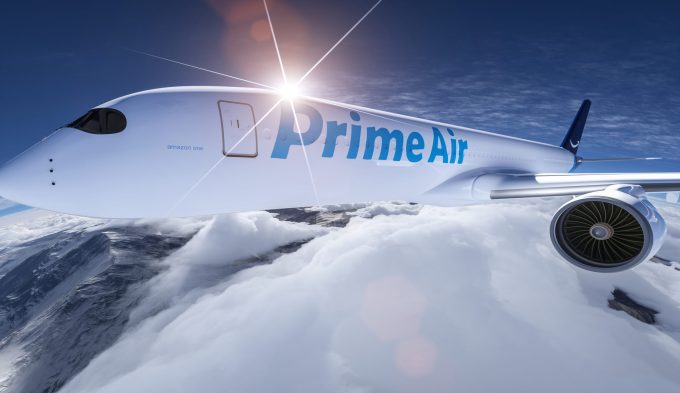MSC adds more ULCVs to orderbook that equates with world's sixth-largest carrier
Undeterred by the threat of additional overcapacity, MSC has ordered a further ten 24,000 teu ...
FDX: ABOUT USPS PRIVATISATIONFDX: CCO VIEWFDX: LOWER GUIDANCE FDX: DISRUPTING AIR FREIGHTFDX: FOCUS ON KEY VERTICALFDX: LTL OUTLOOKGXO: NEW LOW LINE: NEW LOW FDX: INDUSTRIAL WOESFDX: HEALTH CHECKFDX: TRADING UPDATEWMT: GREEN WOESFDX: FREIGHT BREAK-UPFDX: WAITING FOR THE SPINHON: BREAK-UP ALLUREDSV: BREACHING SUPPORTVW: BOLT-ON DEALAMZN: TOP PICK
FDX: ABOUT USPS PRIVATISATIONFDX: CCO VIEWFDX: LOWER GUIDANCE FDX: DISRUPTING AIR FREIGHTFDX: FOCUS ON KEY VERTICALFDX: LTL OUTLOOKGXO: NEW LOW LINE: NEW LOW FDX: INDUSTRIAL WOESFDX: HEALTH CHECKFDX: TRADING UPDATEWMT: GREEN WOESFDX: FREIGHT BREAK-UPFDX: WAITING FOR THE SPINHON: BREAK-UP ALLUREDSV: BREACHING SUPPORTVW: BOLT-ON DEALAMZN: TOP PICK

The announcement that Amazon’s freighter arm is accepting air cargo from third parties like freight forwarders has been greeted with frowns. While airfreight capacity has lagged the expansion in demand, many people in the industry had misgivings if Amazon would put their cargo on hold in the event of a surge in its own parcel traffic.
Tom Bradley, Amazon Air Cargo global director and general manager, has been busy reassuring people that there is no cause for concern. He stressed that the capacity of its network and the use of technology to predict volumes would eliminate potential clashes between Amazon’s own and third-party shipments.
Industry sage Ram Menen, the former head of Emirates SkyCargo, observed that the integrated express carriers tended to prioritise their own express shipments, which comprised of B2B traffic with commitments for time-definite delivery.
“In Amazon’s case, they are more in control as it is their own business and it is their own costs that they are dealing with,” he said. “All Amazon has to do is allocate a certain variable portion of their capacity for committed third-party sale and this allocation becomes a kind of guaranteed space.”
He added that the use of predictive analytics enables Amazon to make highly accurate forecasts of its own volumes and tag on third-party cargo.
Listen to this clip from The Loadstar Podcast to hear The Loadstar’s publisher Alex Lennane speaking to host Mike King about Amazon’s move into air cargo:
While concerns over guaranteed space have swirled around the market entry of Amazon Air Cargo, there has been less attention to the question in how far its capacity meets the needs of the market. What are the chances that it has space available in lanes that command little interest but is close to capacity in sectors in hot demand?
Amazon Air and the carriers that make up its network are unlikely to bring relief to forwarders on high-demand trunk routes out of Asia, but they can be part of a solution. Kuehne + Nagel found that Amazon can help it move ecommerce traffic halfway across the Pacific. It is using Amazon Air from Honolulu to the continental US to relay ecommerce from China.
Joe Schwieterman, director of the Chaddick Institute for Metropolitan Development at DePaul University, has tracked the progress of Amazon Air in recent years. He reckons that opening up the network to third-party traffic “has considerable upside for Amazon Air” to gain traction in the market.
Amazon’s schedules have become more regular over time since its early days when it was showing a higher propensity to change schedules daily or weekly, he remarked. This greatly facilitates Amazon’s ability to make commitments for regular moves rather than just pick up ad hoc traffic.
While its schedule was becoming increasingly set, Amazon was also shifting from a point-to-point network to a greater focus on hubs. The expansion of its main hub at Cincinnati-Northern Kentucky airport (CVG) and other hubs allows Amazon to offer more comprehensive shipping options, Mr Schwieterman commented.
A third point in Amazon Air Cargo’s favour is the directional imbalance that characterises many of the carrier’s lanes touching its hubs, as this means significant unused space on many flights, he remarked.
Directional imbalances are nothing new in the industry and a regular feature of the flight networks of the large parcel integrators, but in Amazon Air’s case they are more pronounced, with three of its four hubs showing imbalances of 18% or more, according to Mr Schwieterman’s research.
“At San Bernardino International and Fort Worth Alliance, the gaps are 32.2% and 25.7%, respectively, while at CVG, it was 17.7%. FedEx’s or UPS’s largest hubs have more balanced flows, as does Amazon’s Wilmington hub,” he observed.
These imbalances are all tilted to the outbound legs from the hubs, which he attributes chiefly to “Amazon’s clustering of fulfilment centres, warehouses, and other strategic assets around its airline hubs, which make these airports large traffic generators”.
Which suggests that a forwarder looking for lift to CVG is more likely to find space on Amazon Air than somebody with a shipment originating in the CVG area.
Another question is which kinds of traffic can be flown through Amazon Air Cargo. According to the company, there are no constraints – dangerous goods are accepted as are pharmaceuticals or perishables – and charters are also available.
Several industry executives reckon that the scope for charters is likely limited to weekends, as Amazon’s commitment to rapid deliveries more or less shackles the freighters to their schedule. Amazon did not provide answers to questions about restrictions on cargo and its capacity to handle temperature-sensitive shipments.
Meanwhile, The Loadstar also reported today that Vancouver International Airport (YVR) has been forced to close its North Runway after an aircraft operated on behalf of Amazon’s Prime Air skidded off the tarmac.
Comment on this article